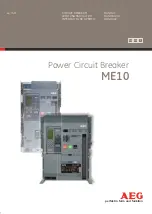
22
Instruction Book
IB182942EN July 2018 www.eaton.com
DST-2-VR
+
VR-Series
+
Replacement Circuit Breaker
Figurt 5.2. DST-2-7.5-VR
+
in tht Disconntct Position
the disconnect and test positions and remain open between the
test and connect positions. (Refer to Section 4.7 for information
concerning correct operation of these components).
5.10 OPERATION, INSERTION AND REMOVAL (LEVERING-
IN VERSION)
5.10.1 OPERATIONAL POSITIONS (LEVERING-IN VERSION)
The breaker has four basic operational positions:
(1) Breaker withdrawn from cell. In the “withdrawn” position the
breaker is out of the cell. The levering handle is not required for
this position. The breaker can be operated in this position and
extreme care should be exercised to avoid inadvertent operation
and possible injury or equipment damage.
(2) Breaker in the cell in the disconnect position. (Figure 5.1) As
the breaker is pushed into the cell it will reach a position where
all four wheels are on the cell floor guide rails and the floor spring
discharge interlock has not activated. (For Canadian breakers the
interlock plunger will rest in the first cell position.) This is the
“disconnect” position and the breaker can be manually operated
because there is no interface of the cell floor interlocks with
breaker interlock linkage. No cell labeling is provided to verify this
position.
(3) Breaker in the test position. (Figure 5.2) The “test” position is
achieved when the breaker has advanced into the cell from the
disconnect position and the audible click of the lock engaging
the interlock rail has been observed. (For Canadian breakers, the
interlock plunger will rest in the second cell position.) The test
position can be verified by the inability to move the breaker in
or out, the Interlock Pedal is in the up position, and the cell label
“test” is visible on the floor of the cell in front of the breaker’s left
front wheel.
(4) Breaker in the connect position. (Figure 5.4) The “connect”
position is achieved by moving the breaker into the cell using
the levering handle until a mechanical stop is reached. As the
breaker is advanced from the test position, the primary voltage
source shutters will open allowing the breaker stabs to engage
with the source. This is the fully engaged or connected position.
The connect position can be verified by the inability to move
the breaker in or out, and the cell label “operating” is visible on
the floor of the cell in front of the breaker’s left front wheel. The
breaker is now ready for service.
WARNING
DO NOT USE ANY TOOL TO LEVER THE BREAKER FROM TEST OR
CONNECTED POSITION OTHER THAN THE LEVERING HANDLE.
5.10.2 INSERTION PROCEDURE (LEVERING-IN VERSION)
a. Place the breaker in the withdrawn position. In the “withdrawn”
position the breaker is out of the cell. The levering handle is
not required for this position. The breaker can be operated in
this position and extreme care should be exercised to avoid
inadvertent operation and possible injury or equipment damage.
WARNING
THE BREAKER CAN BE OPERATED IN THE WITHDRAWN POSITION
AND EXTREME CARE SHOULD BE EXERCISED TO AVOID INADVERTENT
OPERATION AND POSSIBLE INJURY OR EQUIPMENT DAMAGE.
b. From the withdrawn position, align the center groove of the
breaker wheels with the guide rails of the cell.
c. Check that the closing spring status indicator reads
“DISCHARGED” and that the main contact status indicator reads
“OPEN”. Manually trip, close, and trip the breaker as needed to
obtain this status.
Figurt 5.3. Ltvtring-In Instrtion of DST-2-7.5-VR













































